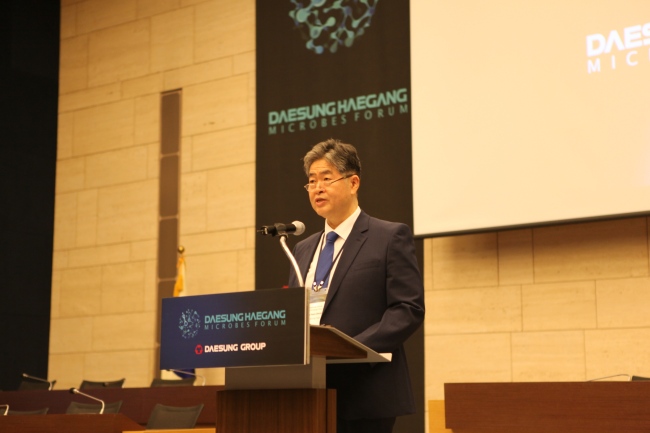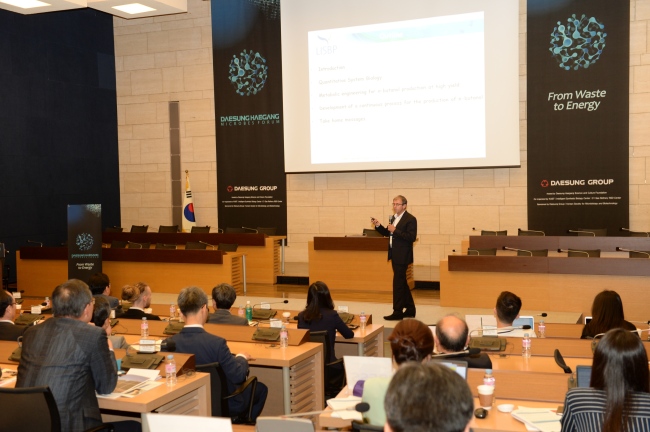Members of academia and businesses gathered in Seoul on Thursday to discuss how to tackle environment and energy problems through microbial waste management at the 2018 Daesung Haegang Microbes Forum.
With the theme of “From Waste to Energy,” the forum was attended by around 120 participants. It is aimed at having experts contribute to the joint development of both the environment and energy fields through discussions about the technical challenges and potential commercialization of cutting-edge technology, according to forum host Daesung Group.

Younghoon David Kim, chairman of Daesung Group, gives an opening speech at the 2018 Daesung Haegang Microbes Forum in Seoul on Thursday. (Daesung Group)
“As the world hurtles toward its urban future, the amount of municipal solid waste is growing even faster than the rate of urbanization,” said Younghoon David Kim, chairman of Daesung Group, in an opening speech at the forum, which was also held last year.
By 2025, the urban population is predicted to increase to 4.3 billion, generating about 2.2 billion tons of municipal solid waste per year, according to the World Bank.
“Such waste should be treated by environmentally friendly methods by transforming it into new sources of energy or into raw materials that can be used to manufacture new products,” Kim said.
He added his personal interest is “the potential of cutting-edge bio-based technologies.”
Founded in 1947 by Kim Soo-keun, Daesung Group is an energy conglomerate providing solutions in the fields of city gas supply, renewable energy, waste-to-energy and other sectors.
Daesung Chairman Younghoon David Kim said, “Through the forum, I wish to contribute to the development of technological advances that can lead the way toward a sustainable environmental and energy system.”
Following the opening speech, experts and professors presented innovative technologies that envision disruptive methods of transforming noxious waste gases and solid waste into energy to minimize damage to the environment.
Philippe Soucaille, professor of Institut National des Sciences Appliquees of France, talked about the production process and technology of bio butanol.
Bio butanol is bio fuel produced through fermentation of microorganism using diverse nonedible biomass such as waste wood, sawdust and agricultural by-products.
“Because bio butanol has higher energy efficiency compared to bio ethanol and it can be used for diverse areas, including gasoline-powered cars, paint and ink, research is ongoing to improve productivity and economic feasibility,” Soucaille said.

(Daesung Group)
Michael Koepke, director of the synthetic biology team at the US-based company LanzaTech, carried out in-depth presentation and discussion on biological and chemical conversion technologies that produce high value-added chemical materials from C1 Gas.
He introduced a gas fermentation platform for commercial-scale production of fuels and chemicals from sustainable low cost feedstocks.
Three other presenters include Chen Yang, a professor at Chinese Academy of Sciences, Jung Gyoo-yeol, a professor at Pohang University of Science and Technology and Lee Eun-yeol, a professor at Kyung Hee University and bio director of the C1 Gas Refinery R&D Center.
After the presentation, the five presenters discussed the possibilities of commercializing high technologies and technical challenges with the moderator Cho Byung-kwan, an expert on bioenergy and synthetic biotechnology.
At separate sessions for up-and-coming scientists in microbial energy, Seo Sang-Woo, a professor at Seoul National University, and other professors announced the results of their research on waste recycling through synthetic microbes, environmental engineering of microbes for reduction of greenhouse gases and more.
The co-organizers of the event are the Korea Advanced Institute of Science and Technology, the Intelligent Synthetic Biology Center led by the government, and the C1 Gas Refinery R&D Center under the Korean Ministry of Science and ICT.
By Shin Ji-hye (
shinjh@heraldcorp.com)







![[KH Explains] Hyundai's full hybrid edge to pay off amid slow transition to pure EVs](http://res.heraldm.com/phpwas/restmb_idxmake.php?idx=645&simg=/content/image/2024/04/18/20240418050645_0.jpg&u=20240419100350)